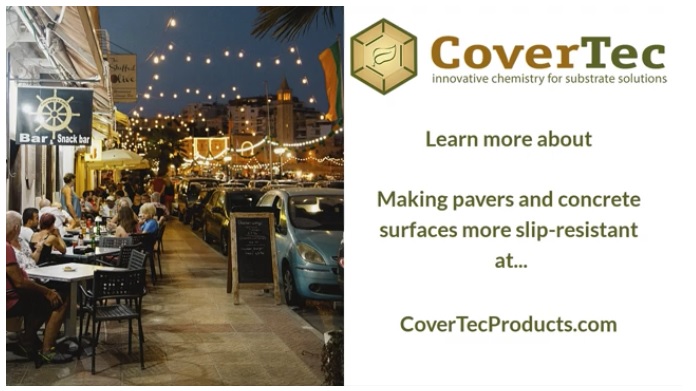How Do You Stop Pavers From Being Slippery by CoverTec Products
How Do You Stop Pavers From Being Slippery
Almost every day, I get this question from customers calling our office. Even though the customers’ environments vary, my responses are usually similar. My advice is usually something like this.
There are 3 methods you could use to stop pavers from being slippery.
- First, you could clean the paver every time you notice anything on the surface that could be slippery – if you had that kind of free time.
- Second, you could use a surface treatment that manages the causes of slippery conditions.
- And third, you could use a sealer to increase the friction on the surface. All of these are useful solutions, and it all depends on your goal.
With the cleaning method, obviously you need to get the mold and mildew, food contaminants or water spills off the surface. This can be done by sweeping or mopping to minimize the “slippery when wet” conditions. However, this is not always possible. This is when you need to look at the second option of using surface treatments.
Applying treatments on the surface of the paver should change its characteristics to manage water and other slip-causing agents more effectively. The result being that when you walk or run on the surface – rather than aquaplaning – you have adequate traction to be safe.
The third option is to use sealers. And there are 2 basics types you need to be aware of:
If you choose to work with a Topical sealer, use one that contains an anti-slip additive that increases the friction on the surface. This will make it much harder for you to slip when moving across the surface. Otherwise, you can use a Penetrating sealer that soaks into the pavers’ pores and does not leave the surface slick or in a slippery condition.
Is Paver Sealer Slippery?
Paver sealer products can be slippery if applied too thick, leaving behind a slick film on the surface. Avoid this situation by using thin mil sealers that penetrate deep into the surface and leave a very thin film on the surface.
You can also use additives in the sealer itself to increase the friction on the surface. Again, you can always use a penetrating sealer that will soak into the sub-surface, without leaving a slippery film behind.
We can scientifically measure how slippery a paver or tile surface is. Watch this video to see how we do this on a customer’s pool deck pavers – before and after – they use our pro-grade products.

It’s all about finding the right anti-slip product for the floor surface you are walking on.
As always, if you have any questions about which product is the best for your unique situation, call us at: 754-253-3401
View our Membership Page on sfpma members directory
Discover more from SFPMA
Subscribe to get the latest posts sent to your email.


